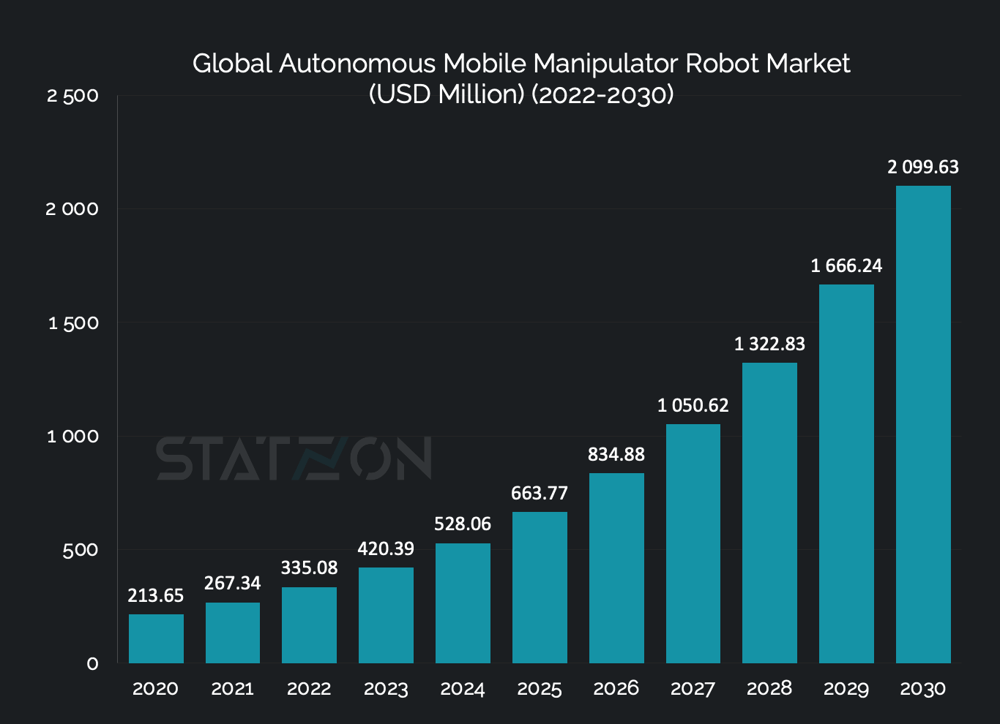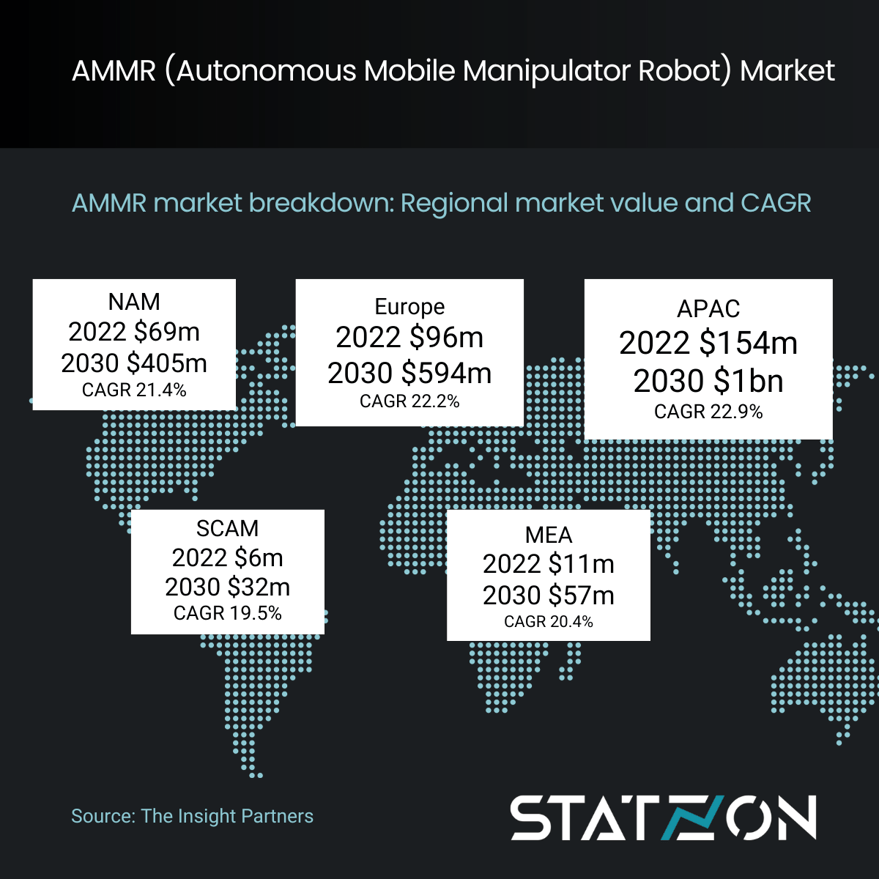What is an Autonomous Mobile Manipulator Robot (AMMR)?
An Autonomous Mobile Manipulator Robot (AMMR) is a versatile robotic system designed for tasks that require both mobility and manipulation in diverse environments. These robots are equipped with three core features: a mobile base for movement (wheels, tracks, or legs), a manipulative robotic arm with joints and grippers, and advanced autonomous navigation capabilities for obstacle avoidance, route planning, and safe operation in dynamic settings. AMMRs find applications in manufacturing, logistics, healthcare, research, and more.
AMR vs. AMMR, how are they different?
AMR (Autonomous Mobile Robot) is mainly about mobility. It moves autonomously but doesn't have a robotic arm. You'll often see AMRs in places like warehouses, moving goods, or doing surveillance. They are simpler in design compared to AMMRs and are used when you only need a robot to move around autonomously. Both can be designed to collaborate safely with humans if needed, depending on the application.
AMMR (Autonomous Mobile Manipulator Robot), on the other hand, combines mobility and manipulation capabilities. It has a mobile base for moving around and a robotic arm for tasks like grabbing and assembling objects. In short, AMMRs are AMRs equipped with a robotic arm. These robots are versatile and find use in manufacturing, healthcare, and more, handling tasks that need both mobility and manipulation abilities.
AMMR vs. collaborative robot, how are they different?
Autonomous Mobile Manipulator Robots (AMMRs) can be designed to be collaborative, but not all AMMRs are inherently collaborative robots. The term "collaborative robot" typically refers to robots designed to work safely alongside humans in a shared workspace. These robots have safety features and sensors to detect and react to human presence, ensuring that they can operate without causing harm to humans.
AMMRs, on the other hand, are defined by their combination of mobility and manipulation capabilities. Whether or not they are considered collaborative depends on their specific design and intended use. Some AMMRs are indeed designed with collaborative features, such as force and torque sensors, soft materials, and safety systems, allowing them to work safely around humans. Others may be designed for tasks in isolated or controlled environments and may not have the same level of collaborative functionality.
Global market for autonomous mobile manipulator robots
 Source: Statzon/ The Insight Partners
Source: Statzon/ The Insight Partners
Based on the latest market report from The Insight Partners, the worldwide market for AMMR was worth USD 335.08 million in 2022 and is projected to attain USD 2.1 billion by 2030, demonstrating an estimated CAGR of 22.3% throughout the forecast period. The growth of the autonomous market is driven by the booming e-commerce sector, which seeks automation solutions to handle higher product volumes and customer demand for quicker deliveries. Many e-commerce players are swiftly embracing AMMR and similar automated solutions to efficiently manage goods and information, meeting customer expectations for speedy deliveries.
AMMR global market segmented by region
The Asia-Pacific (APAC) region emerged as the largest market for AMMR in 2022, capturing a substantial 45.9% of the global market share. Its market value in the same year amounted to USD 153 million. What's truly striking is the region's rapid growth, with a projected market value of USD 1 billion by 2030 and an impressive CAGR of 22.9%, the highest among other regions. This dynamic growth underscores APAC's robust adoption of AMMR technology.
In Europe, the AMMR market had a 25.8% share of the global market in 2022, amounting to USD 95 million. With a CAGR of 22.2%, the region is set to witness substantial expansion, projecting a market value of USD 593 million by 2030.
Meanwhile, North America held a 20.5% market share in 2022, with a value of USD 68 million. While slightly behind APAC and Europe, North America's AMMR market is still expected to experience significant growth, reaching USD 404 million by 2030, with a CAGR of 21.4%.

AMMR global market segmented by type of robot
Based on the type of robot, the global autonomous mobile manipulator robot market is divided into two main categories: differential and omnidirectional.
Differential AMMRs typically have two powered wheels (or sets of wheels) that are independently controlled. They can move forward and backward by driving both wheels in the same direction, and they can turn by driving the wheels in opposite directions. Omnidirectional AMMRs possess the valuable advantage of unrestricted motion, allowing them to navigate in multiple directions. As a result, it is anticipated that in the coming years, omnidirectional robots will significantly expand their market share, underscoring their increasing importance in the industry.
Differential AMMR holds the majority share of the market, accounting for 56% in 2022, with a substantial market worth of USD 1.2 billion. While it currently enjoys the largest market share, its growth pattern is characterized by a more gradual trajectory, featuring a CAGR of 10.4%. Projections indicate that by 2030, it is expected to reach a market value of USD 2.6 billion. With this consistent growth, differential AMMR segment will maintain its prominent presence in the industry, albeit with a comparatively lower growth rate.
Meanwhile, omnidirectional AMMR represents a significant market segment, capturing 44% of the market in 2022, with a market value of USD 147 million. What truly stands out is its remarkable growth potential, boasting an impressive CAGR of 23%. By 2030, omnidirectional AMMRs are poised to attain a market value of USD 974 million.
This remarkable growth suggests that omnidirectional AMMRs could become a major player in the industry, with the potential to compete strongly against Differential AMMRs.
AMMR global market segmented by payload
The global market for autonomous mobile manipulator robots (AMMR) is segmented by payload capacity into four categories: 3-5 KG, 5-10 KG, 10-20 KG, and 20 KG and above. Notably, in 2022, the 10-20 KG segment held the largest market share, commanding 39.1% of the AMMR market. Looking ahead to 2030, this segment is expected to maintain a substantial share, at 32.5%.
Among the payload segments, the 3-5 KG category demonstrated rapid growth, with a remarkable Compound Annual Growth Rate (CAGR) of 24.3%. It accounted for 12.2% of the market in 2022, with a market value of USD 41 million, projected to reach USD 302 million by 2030. Similarly, the 5-10 KG segment, with a CAGR of 23.1%, represented 30.8% of the market in 2022, translating to a market value of USD 103 million, set to rise to USD 689 million by 2030.
While the 10-20 KG segment is currently the market leader, with a market value of USD 130 million in 2022, it is expected to grow steadily with a CAGR of 19.8%, reaching USD 682 million in 2030. Lastly, the >20 KG category, which accounted for 17.8% of the market in 2022 (USD 59 million), is projected to experience robust growth with a CAGR of 24%, reaching USD 425 million by 2030.
In summary, the 10-20 KG segment currently dominates the AMMR market, but the 3-5 KG and 5-10 KG segments are showing impressive growth rates. Their expanding market presence hints at a potential shift in the landscape, challenging the dominance of the 10-20 KG segment in the coming years.
Top companies in AMMR global market
The Insight Partners has identified five key players in the global autonomous mobile manipulator robot market: KUKA, Boston Dynamics, OMRON, Han's Laser, and Neobotix. Given the market's fragmented nature with numerous businesses catering to local demand, listing these key players based solely on revenue is challenging. Instead, The Insight Partners selected these top companies based on various essential factors such as overall revenue, brand reputation, industry experience, product portfolio, technology innovation, customer base, geographical presence, partnerships, and market-related activities. These factors collectively highlight their significance in the market.
Source: Statzon, The Insight Partners report on global AMMR market



